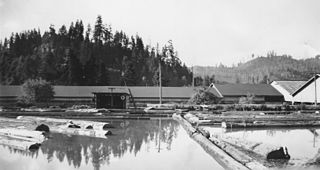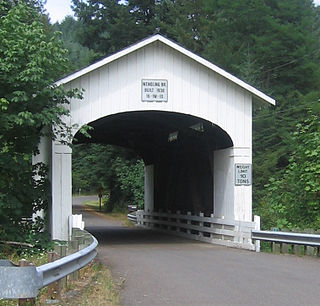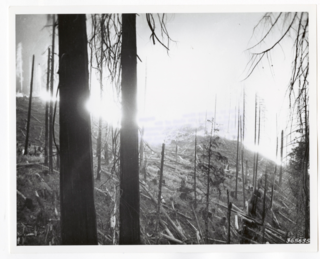
Oakridge is a city in Lane County, Oregon, United States. The population was 3,205 as of the 2010 census. It is located east of Westfir on Oregon Route 58, about 40 miles (64 km) east of Eugene and 150 miles (240 km) southeast of Portland. Surrounded by the Willamette National Forest and the Cascade Range, Oakridge is popular with outdoor enthusiasts for its hiking, mountain biking, wildflowers, fly fishing, birding, watersports, and the nearby Willamette Pass Resort.

The Mohawk River is the largest tributary of the McKenzie River, approximately 30 miles (48 km) long, in west central Oregon in the United States. It drains part of the foothills of the Cascade Range on the southeast end of the Willamette Valley northeast of Springfield.

Goshen is an unincorporated community in Lane County, Oregon, United States. It is located at the junction of Oregon Route 58, Oregon Route 99, and Interstate 5.

The Oregon, Pacific and Eastern Railway is an Oregon-based short line railroad that began near Eugene as the Oregon and Southeastern Railroad (O&SE) in 1904. O&SE's line ran 18 miles (29 km) along the Row River between the towns of Cottage Grove and Disston. The Oregon, Pacific & Eastern Railway Company incorporated in 1912, purchased the physical assets of the O&SE two years later, and shortened their total trackage to operate 16.6 miles (26.7 km) from an interchange yard with the Southern Pacific Railroad at Cottage Grove, east to a 528' x 156' turnaround loop at Culp Creek. The last of this track was closed and scrapped in 1994, and ownership of its abandoned right of way property was later reverted to the state of Oregon to become one of the first-ever Government/Private Sector cooperative partnership Rails to Trails programs in the US, forming the Row River National Recreation Trail. A successor corporation now operates a communications company and a narrow-gauge line at Wildlife Safari.

Marcola is an unincorporated community in Lane County, Oregon, United States, northeast of Springfield on the Mohawk River.
Rockport is a former settlement in an unincorporated area of Mendocino County, California. It is located 7.25 miles (12 km) north-northwest of Westport, at an elevation of 30 feet.
Disston is an unincorporated community in Lane County, Oregon, United States, southeast of Cottage Grove where Brice Creek and Layng Creek join to form the Row River. It is about a mile west of the Umpqua National Forest. Its post office opened in 1906 and ran until 1974. Cranston Jones—the first postmaster—was also one of the founders of the first sawmill in Disston and the name of the town came from the famous Disston saws.

Mohawk is an unincorporated community in Lane County, Oregon, United States, on the Mohawk River, about seven miles upstream from Springfield.

Springfield School District 19, also called Springfield Public Schools, is a public school district in Lane County, Oregon, United States. It serves students in most Springfield, as well as some outlying areas, including Goshen, Mohawk, and Walterville, as well as portions of Marcola.

The Fort Bragg and Southeastern Railroad was formed by Atchison, Topeka and Santa Fe Railway as a consolidation of logging railways extending inland from Albion, California on the coast of Mendocino County. The railroad and its predecessors operated from August 1, 1885 to January 16, 1930. The line was merged into the regional Northwestern Pacific Railroad in 1907; but planned physical connection was never completed.

Vaughn is an unincorporated community in Lane County, Oregon, United States. It is located about 4 miles (6.4 km) south of Noti in the foothills of the Central Oregon Coast Range near Noti Creek. Author Ralph Friedman described Vaughn as "a mill in the meadows".

The Oregon and Northwestern Railroad (O&NW) is a defunct railroad in eastern Oregon in the United States. It ran 50.2 miles (80.8 km) from Hines north to Seneca, which is on the edge of the Malheur National Forest, over a total of 19 trestles.

Springfield is a city in Lane County, Oregon, United States. Located in the Southern Willamette Valley, it is within the Eugene-Springfield Metropolitan Statistical Area. Separated from Eugene to the west, mainly by Interstate 5, Springfield is the second-most populous city in the metropolitan area after Eugene. As of the 2020 census, the city has a total population of 61,851, making it the 9th most populous city in Oregon.
Yarnell is an unincorporated historic locale in Lane County, Oregon, United States. It was located about 5 miles south of Mohawk, in the Mohawk Valley.
Black Rock is an unincorporated community and former logging camp in Polk County, Oregon, United States. It is located about three miles west of Falls City, in the Central Oregon Coast Range on the Little Luckiamute River.

Mill Creek is a tributary of the Mohawk River in Lane County in the U.S. state of Oregon. It begins in the foothills of the Cascade Range northeast of Springfield and flows generally west through Wendling to meet the river near Marcola. The confluence is about 13 river miles (21 km) from the Mohawk's mouth on the McKenzie River. Mill Creek's named tributaries from source to mouth are Straight, Nebo, Deer, Oshkosh, and Wolf creeks.

Brooks-Scanlon Lumber Company was a lumber products company with large sawmills and significant land holdings in Minnesota, Florida, British Columbia, and Central Oregon. The company was formed in 1901 with its headquarters in Minneapolis, Minnesota. Beginning in 1915, its main lumber production facility was in Bend, Oregon. For many years, its Bend sawmill was one of the largest lumber producers in the world. In 1969, the company created Brooks Resources to broaden its business base beyond timber production. Brooks-Scanlon's Bend sawmill was closed in 1994. Today, Brooks Resources is the only vestige of the company that is still in business.

Consolidated Timber Company was an American lumber company that operated a large sawmill near Glenwood, Oregon, circa 1936–1946.

The Hayden RR Bridge, is a truss bridge located in Springfield, Oregon, spanning over the McKenzie River. It initially served as a traditional railroad bridge, starting as part of the first transcontinental railroad in Utah, before moving to its current location as part of the Marcola line, whose primary use was the distribution of lumber. It later closed alongside the area's lumber mills, and became a pedestrian bridge in 2019. It is one of the few remaining wrought-iron, Phoenixville bridges still standing, and the oldest intact bridge in the state of Oregon.

The Mims House in Eugene, Oregon, USA, is a Gothic Revival-style, single-family home considered to be one of the oldest homes in the area. It is known for being the home of the Mims family, who were one of the first African American homeowners in Eugene when they purchased it in 1948. During the period of racial segregation in Eugene, the Mims family frequently hosted African American visitors to Eugene both at their home and in the adjoining boarding house which they owned. The building is a Historic Landmark located within the East Skinner Butte Historic District. In 2021, the Eugene-Springfield branch of the NAACP was located in the Mims House, although the home also operates as a museum.



















